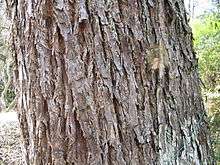Choerospondias axillaris
Choerospondias axillaris, known in English as the Nepali hog plum, is a tree in the family Anacardiaceae. It is a common fruit in Nepal also called lapsi. It is native to much of Asia from India to China to Japan to Bhutan and Nepal. Its fruit is about 3 centimeters long and has a soft whitish sour flesh and green to yellow skin. The fruit is made into pickles, fruit tarts, and sour, spicy candy in Nepal. The tree has long been cultivated in rural Nepal for its fruit.[1] The fruit is nutritious and has a price comparable to the mandarin orange on the Nepalese market.[1]
| Choerospondias axillaris | |
|---|---|
 | |
| Scientific classification | |
| Kingdom: | Plantae |
| Clade: | Tracheophytes |
| Clade: | Angiosperms |
| Clade: | Eudicots |
| Clade: | Rosids |
| Order: | Sapindales |
| Family: | Anacardiaceae |
| Genus: | Choerospondias |
| Species: | C. axillaris |
| Binomial name | |
| Choerospondias axillaris | |
This is a deciduous tree growing up to 20 meters tall. The smaller branches are purple-brown in color. The compound leaves are up to 40 cm (16 in) long and divided into 3 to 6 papery oval leaflets each up to 12 cm × 4.5 cm (4.7 in × 1.8 in).[2] The tree is dioecious, with male and female trees producing different types of inflorescence.[1] Male flowers occur in long clusters and have curving, brown-veined petals about 3 millimeters long. Female flowers are solitary in leaf axils at the tips of branches. They are larger than the male flowers and yield the edible drupe. The fallen fruits are consumed and dispersed by sambar and barking deer.[3][4]
Besides fruit, the tree yields valuable wood and hard seeds which are burned for fuel, and has parts used medicinally in Vietnam.[1]
Catechin-7-O-glucoside can be found in the stem barks of C. axillaris.[5]
Gallery
References
- Poudel, K. C. (2003). "Domestication of Lapsi Choerospondias axillaris (Roxb.) B.L. Burtt & A.W. Hill for fruit production in the middle mountain agroforestry systems of Nepal". Himalayan Journal of Sciences. 1 (1): 55–58.
- Tianlu Min; Anders Barfod. "Choerospondias axillaris". Flora of China. Missouri Botanical Garden, St. Louis, MO & Harvard University Herbaria, Cambridge, MA. Retrieved 2 March 2013.
- Brodie JF; OE Helmy; WY Brockelman; JL Maron (2009). "Functional differences within a guild of tropical mammalian frugivores" (PDF). Ecology. 90 (3): 688–698. doi:10.1890/08-0111.1. Archived from the original (PDF) on 2010-12-30. Retrieved 2014-12-12.
- Chen, J.; Deng, X.B.; Bai, Z.L.; Yang, Q.; Chen, G.Q.; Liu, Y. & Liu, Z.Q. (2002). "Fruit characteristics and Muntiacus muntjac vaginalis (Muntjac) visits to individual plants of Choerospondias axillaris". Biotropica. 33: 718–722. doi:10.1111/j.1744-7429.2001.tb00231.x.
- Flavanoidal constituents of Choerospondias axillaries and their in vitro antitumor and anti-hypoxia activities. Li Chang-wei, Cui Cheng-bin, Cai Bing, Han Bing, Li Ming-ming and Fan Ming, Chinese Journal of Medicinal Chemistry, 2009, 19 (1), pages 48-51,64 (abstract Archived 2014-03-09 at the Wayback Machine)
This article incorporates text from a publication now in the public domain: Wood, James, ed. (1907). "article name needed". The Nuttall Encyclopædia. London and New York: Frederick Warne.

